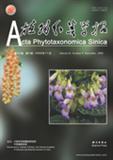WANG Wen-Tsai
Clematis sect. Naraveliopsis is revised in this paper. Twenty-one species with one subspecies and one variety of sect. Naraveliopsis, which are widespread in tropical Asia, are recognized. Of them, one species, C. vietnamensis W. T. Wang & N. T. Do, is described as new from Vietnam. They are keyed, described, and illustrated in most cases, and classified into three subsections. Brief taxonomic history and geographical distribution of the section are given, and its systematic position and origin are discussed. The classification proposed by Wang (2000) is revised with reduction of the subsect. Liboenses ser. Loureirianae. According to the evolutionary trends observed, subsect. Liboenses, characterized by having bisexual flowers and hairy stamens, and subsect. Macgregorianae, characterized by having unisexual flowers, are regarded as advanced groups. In the primitive subsect. Smilacifoliae, characterized by having bisexual flowers and glabrous stamens, C. smilacifolia and C. fulvicoma, which have simple leaves, no staminodes, and short connective projections, are considered as the primitive species. C. vietnamensis and C. loureiriana, which have ternate leaves and staminodes, and C. papillosa, which have pinnate leaves and long connective projections, are recognized as the advanced species of that subsection. The montane regions of northern Indochina Peninsula plus southern Yunnan-Guizhou Plateau and the eastern Himalaya, where 13 species of sect. Naraveliopsis are concentrated, is regarded as the distribution centre. The part within the montane regions mentioned above, where the distribution areas of C. smilacifolia and C. fulvicoma overlap, may be the centre of origin of sect. Naraveliopsis.

